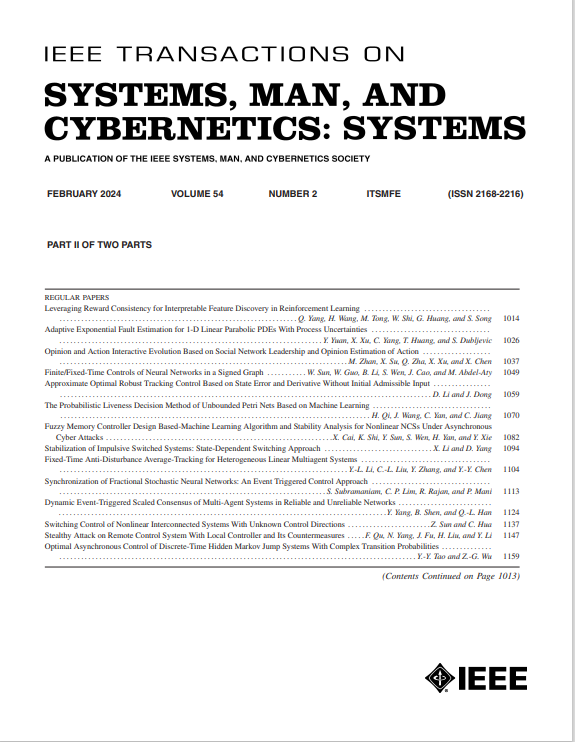Enhancing Robotic Surgery With Haptic Feedback: A Cooperative Control Strategy for Autonomous Laparoscope Control
IF 8.7
1区 计算机科学
Q1 AUTOMATION & CONTROL SYSTEMS
IEEE Transactions on Systems Man Cybernetics-Systems
Pub Date : 2025-07-03
DOI:10.1109/TSMC.2025.3579383
引用次数: 0
Abstract
The development of autonomous laparoscope control in robot-assisted surgery has emerged as a significant research area, particularly due to its potential to reduce assistant fatigue and minimize miscommunication between the surgeon and assistant. A notable challenge, however, is the tendency of autonomous control strategies to override the surgeon’s direct command occasionally. To address this issue, we propose a novel haptic feedback-based cooperative control strategy that enhances the surgeon’s command of laparoscopic field of view (FOV) movement in robot-assisted laparoscopic surgery. Specifically, we first established a dynamic model of the laparoscope-holding robot, which serves as a link between the movement of the laparoscopic FOV and the surgical instruments to deliver haptic feedback to the surgeon. Next, a motion observer was developed to transform 30 Hz visual feedback into 1 kHz haptic feedback by integrating visual tracking data with kinematic information, ensuring smoother and more continuous haptic feedback. Finally, we propose two distinct collaboration modes: the plane tracking mode (PTM) ensures instruments remain within the laparoscopic image, and the space tracking mode (STM) synchronizes the laparoscope with instrument movement. The laboratory experiments validated the effectiveness of the proposed method in enhancing the cooperative performance of robot-assisted laparoscope systems while animal experiments demonstrated the feasibility of the PTM design.用触觉反馈增强机器人手术:一种自主腹腔镜控制的协同控制策略
在机器人辅助手术中自主腹腔镜控制的发展已经成为一个重要的研究领域,特别是因为它有可能减少助手的疲劳和减少外科医生和助手之间的错误沟通。然而,一个值得注意的挑战是,自主控制策略有时会超越外科医生的直接命令。为了解决这一问题,我们提出了一种新的基于触觉反馈的协同控制策略,以提高外科医生在机器人辅助腹腔镜手术中对腹腔镜视场运动的指挥。具体而言,我们首先建立了持腹腔镜机器人的动力学模型,该模型作为腹腔镜视场与手术器械运动之间的联系,向外科医生提供触觉反馈。接下来,开发了一个运动观测器,将视觉跟踪数据与运动学信息相结合,将30 Hz的视觉反馈转化为1 kHz的触觉反馈,确保触觉反馈更平滑、更连续。最后,我们提出了两种不同的协作模式:平面跟踪模式(PTM)确保仪器保持在腹腔镜图像内,空间跟踪模式(STM)使腹腔镜与仪器运动同步。实验室实验验证了该方法在提高机器人辅助腹腔镜系统协同性能方面的有效性,动物实验验证了PTM设计的可行性。
本文章由计算机程序翻译,如有差异,请以英文原文为准。
求助全文
约1分钟内获得全文
求助全文
来源期刊

IEEE Transactions on Systems Man Cybernetics-Systems
AUTOMATION & CONTROL SYSTEMS-COMPUTER SCIENCE, CYBERNETICS
CiteScore
18.50
自引率
11.50%
发文量
812
审稿时长
6 months
期刊介绍:
The IEEE Transactions on Systems, Man, and Cybernetics: Systems encompasses the fields of systems engineering, covering issue formulation, analysis, and modeling throughout the systems engineering lifecycle phases. It addresses decision-making, issue interpretation, systems management, processes, and various methods such as optimization, modeling, and simulation in the development and deployment of large systems.
 求助内容:
求助内容: 应助结果提醒方式:
应助结果提醒方式:


